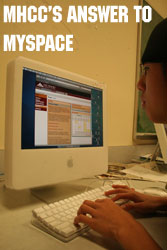MyMHCC: Changing the way students interact with the school
Many students have been wondering why the good ol’ MHCC website (www.mhcc.edu) recieved a facelift winter quarter. Jim Morgan, a Mental Health major, said it best. “At first I didn’t like the new layout. Now I just deal with it. But it seems like you have to click around a lot more than before to find things.” If you’re in the same boat as Morgan, then you are reading the right story. While the new design is a cosmetic change, the web Portal MHCC has launched this spring quarter is the real meat behind a united front to better MHCC student experiences. “You could call it a communication technology,” said Paul Morris, resident technology expert (RTE) coordinator and computer applications specialist. Students may not realize they are familiar with web Portals. Myspace, the popular web-based friend networking/destroying tool, is a Portal. And, like Myspace, the MHCC Portal is set to give students a personal presence at the MHCC website. Celia Carlson is an English instructor at MHCC, and also one of many resident technology experts. As an RTE, Carlson’s job is to educate members of her department on what exactly the Portal is. “The portal is basically a series of ‘web programs’ that facilitate communication between staff, faculty and students at MHCC. Each member of the MHCC community is able to have their own intro page with information catered to them. For students, this would be a list of classes and clubs they’re interested [in]; for faculty, a list of classes and other organizations they belong to at MHCC, etc.” So what does that mean for you, the college student? Paul Morris ran through a demonstration that shows the possibilities. For the classes he is teaching, he has provided mp3s of his lectures, copies of the handouts for students who missed classes, video files, and his student’s progress. Any student in Morris’ classes can access the information that applies to their class, including their attendance. “The potential is there for a teacher to post a bulletin saying I’m sick, no class today. Technology is a tool, and we’re looking for effective ways to use it.” The web Portal is funded by the Title III grant and MHCC. “Title III is a five-year federal grant that the school applied for,” said Steven Smith, a Title III instructional systems designer, who works with the RTEs. “The purpose of the grant was to integrate new technology into the college curriculum, and to prepare the students for technological needs when they graduate. It’s also there to help the faculty and give them new tools.” In regard to portal technology, MHCC is a late bloomer. Both Chemeketa and PCC have effective web portals that are used in the way ours is expected to. That is not to say the system is free of kinks. During Morris’ demonstration, the video files he loaded from the portal would not play. “There are bugs and glitches, we’ve all found them. They’re being reported to Jenzabar, the company that made the portal technology, and are being straightened out.” The problem wasn’t really with the portal but the type of file. The .wmv video format isn’t supported on Macintosh computers, but it’s problems like this that are being ironed out. “As it’s tested, the problems that are there are exposed, and those things need to be worked out,” said Morris. “We want to see it successful.” The potential in the portal technology has Smith excited. “I keep thinking about what a great opportunity it is for the college,” he said. “Students almost expect this kind of technology, and those of us involved have been really looking forward to this moment.” On top of the students not knowing much about it, the staff and faculty are not being required to use it. “Every class is online and in the portal, but as far as what’s there is up to the instructor,” said Morris. “The faculty members who have it up and running are really liking it. We knew it was going to be slow going.” Rob Neilson, student development and services executive dean and the Portal Project leader, shares Smith’s optimism. “The website redesign began about a year ago. We were looking for ways to increase the student’s ability to use technology. This is one of the things that the Title III grant is being used for.” Other parts of the grant include course development and training for the faculty. “It’s all about integrating technology and training students and faculty,” said Smith. Smith naturally hopes to see the project be successful, as he has a lot of personal investment in the project. “I love it. I’ve been doing online learning for eight or nine years now. I was right there when things changed, computers became the standard for an office, and I think it’s great. This is a toolkit, and if it’s used correctly, there is unlimited potential for what the MHCC website can be to the students.” Smith refers to this quarter as ‘Spring Training’. “Students are being introduced to it, faculty and staff are being introduced to it, and that’s the idea of community college: All of us learn together and try to meet each others needs.” Let’s face it: The days of relying solely on face-to-face communication are gone. Our generation depends on tools like the internet and telephones for everything from encyclopedia-like knowledge to personal relationships. We survive by our email and our digitized, pre-paid monthly plans, keeping us a touch closer to the world at large. And finally, MHCC is responding the times. Click here to get instructions on using the portal!
|
